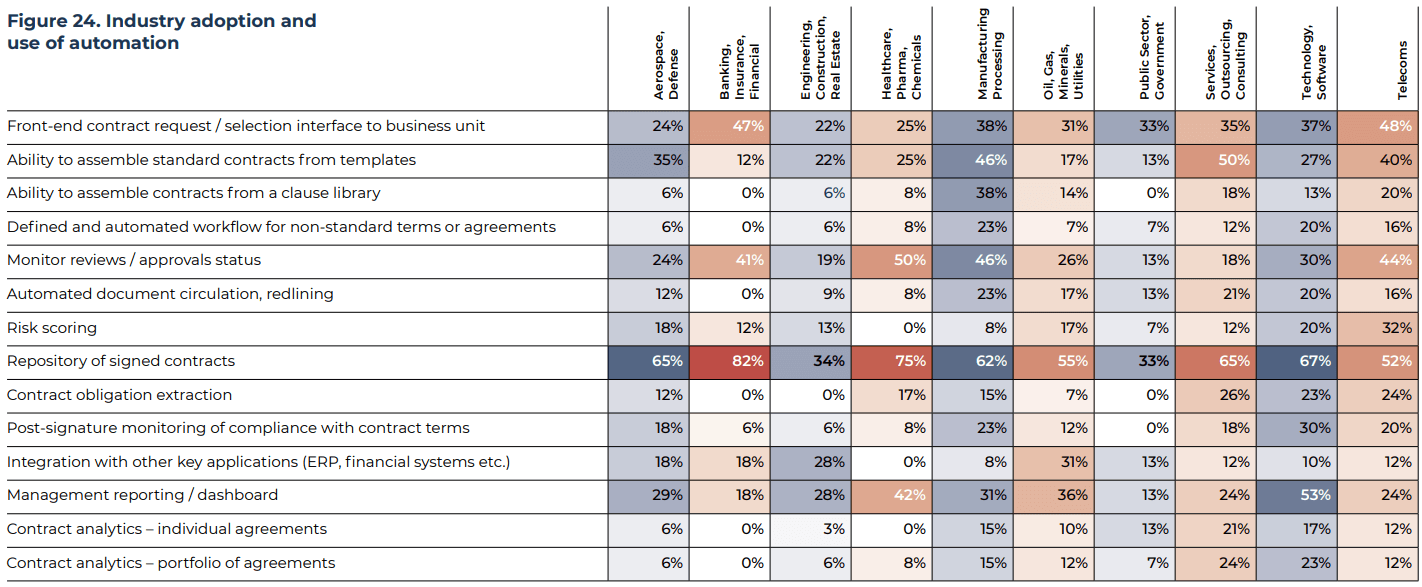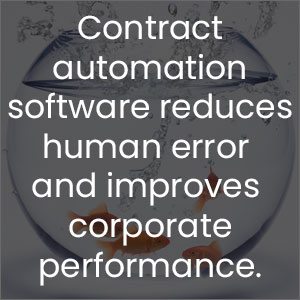This year’s IACCM Benchmark Report 2019 addresses an interesting topic about contract automation. It asks a simple question: “Is the pace of automation picking up?” Generally speaking, automation is starting to gain traction, but from a broad cut – it is still in the early momentum-building stage. One standout is the repository of signed contracts, which is clearly gaining traction.
In another light, business processes seem to be pivoting toward an awareness of the need. The report also highlights that “44% of survey participants say that selecting an automated system or replacing an existing system is a priority in the next twelve months,” (IACCM, 2019, p28). Whether it’s for contract automation software such as contract lifecycle management, document management system, or other enterprise software; legal departments are moving toward greater automation.
Now, how do you head down this road effectively?

CONTRACT AUTOMATION INHIBITORS
IACCM’s report highlights three top automation inhibitors:
- Budget and cost
- Process changes and management
- Time and resources
- Contract automation software reduces human error and improves corporate performance
There is good reason to consider automation systems like contract management software. Whether buy-side or quote to cash, it:
- Shortens approval timing on the sales team’s contracts
- Tightens the contract process (regulation)
- Gives you better control to manage contracts
- Impacts the corporate bottom line
1. BUDGET AND COST
It is impossible to get around it. Budgets are a tough subject. Identified as the top inhibitor by contract managers, it is a topic that will not just vanish. 
First, realize that budget is going to be the first objection to raising the option of getting a contract automation system. Let’s face it, these systems can be expensive. Some systems are multi-functional ERP solutions that encompass just about every aspect of the business. These will go far beyond the boundaries of the legal or contracts team. However, other end-to-end contract lifecycle management (CLM) systems target your needs more specifically. This without the Herculean task of getting the entire corporation on board.
Powerful systems like that of ContractPodAi don’t have to be expensive. Not only does this help you overcome the budget constraint, but it gets your contracts moving faster.
When considering a CLM or other contract automation solutions, naturally look to vendors that are likely to fit your budget. More importantly, consider vendors that provide a fixed price, and that are transparent in discussing their pricing model.
2. PROCESS CHANGE AND MANAGEMENT
Although never an easy topic, process change can be scary. Inevitably, bringing in contract automation will result in process changes. However, look at it as an opportunity to infuse the best practices into your existing contract cycle and approval processes. Process change brings with it the opportunity to make your legal department more impactful, help reduce human error, and even improves your corporate performance.
On corporate performance, think back to the IACCM’s observation that “companies lose 9% of their bottom line through ineffective contract management.” Now, imagine doing some change management and adjusting agreement processes that show an impact on the bottom line. Would that process and automation system be worthwhile? How could that shift the perception of your legal department away from merely being a cost center?
HELP WITH PROCESS CHANGE
Companies lose 9% of their bottom line through ineffective contract management. When speaking with CLM and automation vendors, ask about what they can do to help with your change management efforts. Part of bringing in a contract management system is the impact it will have on the team, structure, and processes. It is important to understand what help you can get from a consulting perspective. Can the vendor offer services that will help you better align your processes to the changes? Does this level of change management come from professed users who have had direct experience on a legal team or in contract management?
Frankly, this is where the tag line “Created by lawyers, for lawyers” truly hits home. Yes, in recent years this line has become popularized by several vendors. In that case, ask them directly for the consulting services mentioned above. Is such an offering included? It can definitely help you directly. Is it offered by lawyers with experience in your role? Ultimately, you need the right change management help that will be respected by your team, and that will be acted upon.
3. TIME AND RESOURCES
Any salesperson will tell you that it’s all about closing deals faster. Whether buy-sided, sell-sided, or functional contracts like NDA’s, IP, HR agreements, and such; speeding up the contract process is important to the general counsel. Contract automation is all about cutting down the time it takes to get to sign-off. 
But, don’t forget that it’s also about the time it takes to get a system like a CLM to be operational. Speed to market is important. In this regard, contract automation software like a CLM should take about 2-3 months for the integration and implementation efforts. Specifically, this is for a system that is largely an out-of-the-box configuration. Any time you need deeper customization, hard coding, or specialized API development – this timing increases.
When starting down this road, keep it simple. Don’t try to take on too much right from the beginning. To increase the probability of fast success, stick to the off-the-shelf solution. Configure it to your needs, rather than customizing it with hard (expensive) code. And, start showing your team’s success – early.
CONTRACT AUTOMATION – GETTING IT RIGHT
IACCM’s recent study shows that the pace of automation is accelerating. This is great news! Certainly, it does not mean we are out of the forest yet. But, it is a good sign.
IACCM further states that “the priority being given to digitization is helping the case for contract automation, since existing methods are becoming inhibitors or roadblocks to wider business process improvement,” (IACCM, 2019, p24). In light of this, it is important to look to the vendors for help with this journey. Ask your technology vendors for help with both the fast implementation of solid automation systems, but also on helping with the change management and process enhancements.
Getting it right comes down to powerful software, fast deployment, and the change management help – to bring the whole team and company along for the journey. And don’t lose sight of the fact that the digital transformation journey is perhaps the most important one your legal team will take – toward success.
Author:

Charles Dimov
Connect with us on Linkedin


